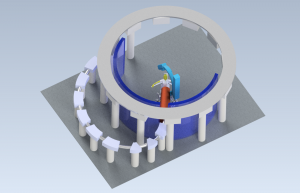Compact Gantry-less Proton Therapy System to Increase the Availability to Patients

Susu Yan, PhD
Division of Radiation Biophysics, Department of Radiation Oncology, Massachusetts General Hospital and Harvard Medical School![]()
Increasing access of particle therapy to many
Proton radiation therapy is generally considered as the most advanced and precise form of radiation therapy. The availability of proton therapy is growing exponentially in recent years. According to PTCOG (Particle Therapy Co-Operative Group), there are 99 proton centers in operation worldwide, 29 centers under construction and 28 centers in the planning stage [1]. However, the long-term projected availability is still very low [2]. Only less than 1% of all radiation therapy patients receive proton therapy, even though between 15% and 50% would benefit from it. The reason for this discrepancy is the high capital cost and the size of the proton therapy equipment. The primary factor contributing to the size and cost is the huge proton gantry.
Proton treatment started with a horizontal beam-line [3]. The gantry was then developed, and centers were built with multiple rooms. In recent years, companies have started to develop “compact” single room system with a full or partial gantry. However, these “compact” systems still need a deep pit for the gantry. A recent study has investigated whether a gantry is necessary by analyzing the beam orientations with a gantry system [4]. The study showed that a horizontal fixed beam-line (with some bending) in combination with patient in sitting, reclined or lying positions could provide most of the beam angles needed for the treatment. The practicality of such a gantry-less system, for example the required immobilization technique [5] and organ deformation [6], have been investigated. With the other two recent advances [1] in adaptive pencil beam scanning and fast imaging system for on-line adaptation and position monitoring, a compact system which can retrofit into a conventional LINAC room can be achieved (Figure 1). Potential clinic benefits of treatment in upright position has been evaluated and shown reduced mean lung dose for thoracic cancer patients [8].
There are more than 8000 conventional LINAC treatment centers worldwide. If the compact gantry-less system could be retrofitted into these centers with a capital cost similar to that of a LINAC, it will dramatically increase the accessibility of proton treatment to patients. Every patient who should benefit from proton therapy will be able to receive it. The disability adjusted life year (DALY), which is a health economic metric to quantify disease burden, could be reduced by millions [7].

Figure 1: Compact gantry-less proton therapy system design. It retrofits in a conventional LINAC treatment room. (3D model by Fernando Hueso-González).
References
[1] https://www.ptcog.ch/index.php/facilities-in-operation
[2] T.R. Bortfeld, J.S. Loeffler. Three ways to make proton therapy affordable. Nature. 2017 Sep 25; 549(7673):451-453. PMID: 28959981.
[3] J.E. Munzenrider, M. Austin-Seymour, P.J. Blitzer, R. Gentry, M. Goitein, E.S. Gragoudas, K. Johnson, A.M. Koehler, P. McNulty. and G. Moulton. Proton therapy at Harvard. Strahlentherapie, 161(12), p.756.n, 1985.
[4] S. Yan, H. Lu, PhD, J. Flanz, J. Adams, A. Trofimov, T. Bortfeld. Reassessment of the necessity of the proton gantry: analysis of beam orientations from 4332 treatments at the Massachusetts General Hospital (MGH) proton center over the past 10 years. International Journal of Radiation Oncology Biology Physics, Sept. 2015.
[5] T. Buchner*, S. Yan*, S. Li, J. Flanz, F. Hueso-Gonzalez, E. Kietly, T. Bortfeld, D. Rus. A soft robotic device for patient immobilization in sitting and reclined positions for a compact proton therapy system. 2020 8th IEEE RAS/EMBS International Conference for Biomedical Robotics and Biomechatronics (BioRob), New York City, NY, USA, 2020.
[6] S. Yan, J. Greenhalgh, S. Li, T. Bortfeld, J. Flanz, An MRI study of organ shape variations between upright, reclined and recumbent positions – implications for compact gantry-less particle therapy, Poster presentation at the 58th PTCOG, Manchester, UK, June 10 -15, 2019.
[7] T. Bortfeld, M. Viana, S. Yan. The societal impact of ion beam therapy. Zeitschrift fur medizinische Physik, July 2020.
[8] J. Yang, D. Chu, L. Dong, L.E. Court. Advantages of simulating thoracic cancer patients in an upright position. Pract Radiat Oncol. 4(1): e53-8, Jan-Feb 2014.

